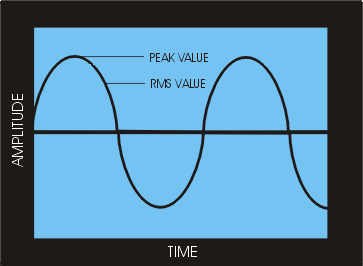Warning: Geeky engineering talk ahead......
Pretend the graph, above, represents a music signal, as it might be viewed on an oscilloscope.
The peak value is the highest voltage that the waveform will ever reach, like the peak is the highest point on a mountain.
The RMS (Root-Mean-Square) value is the effective value of the total waveform. It is really the area under the curve. In audio it is the continuous or music power that the amplifier can deliver.
Peak and RMS only apply to AC (alternating current, like household power and music) signals, not DC (direct current like batteries). For DC the peak and RMS values are equal.
Voltage, current, and power for most all AC circuits is given in RMS. 120 Volt household power (in the US) is an RMS value. Ever heard someone call it 170 volt peak power????
Using RMS values allows for calculations to be completed more easily.
Bottom Line: For audio applications, our ears are RMS instruments, not peak reading. So using RMS values makes sense, and is normally how amplifiers are rated.
If you use an SPL meter (like the popular Radio Shack(TM) model) in fast response mode; you will see peaks in excess of what you calculate with the SPL calculator on this site. The meter is tracking the "peaks". Slow response time will give you an RMS reading, not true RMS, but close enough :)
